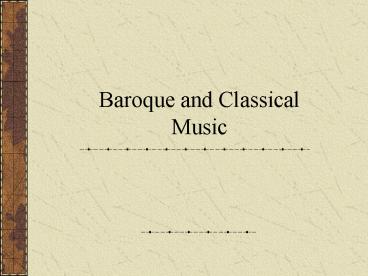Baroque and Classical Music - PowerPoint PPT Presentation
1 / 21
Title:
Baroque and Classical Music
Description:
Romantic (1820-1900) Twentieth Century (1900- present) Modern (1945 ... Melodies tend to have equal four bar phrases split into a 2-bar question and a 2 ... – PowerPoint PPT presentation
Number of Views:292
Avg rating:3.0/5.0
Title: Baroque and Classical Music
1
Baroque and Classical Music
2
Musical Periods
- Medieval (before 1450)
- Renaissance (1450-1600)
- Baroque (1600-1750)
- Classical (1750-1820)
- Romantic (1820-1900)
- Twentieth Century (1900- present)
- Modern (1945-present)
3
Baroque Music
- Baroque music has a recognisable sound.
- The dynamics change suddenly.
- Short musical ideas (motives) and repetition.
- The harmonies are simple (chords I and V).
- The melodies use ornaments.
- Binary, ternary and rondo forms.
- The texture is often contrapuntal/polyphonic.
4
Baroque Instruments
- The harpsichord was popular in Baroque times.
- It was used as a solo instrument or as part of an
orchestra to fill in important harmonies with the
cello or bassoon (continuo). - Other baroque instruments include the flute,
recorder, oboe, bassoon, organ and orchestral
strings.
5
Styles of Baroque Music
- Baroque Music is of many styles
- Italian, French, English, German.
- Early, middle and late.
- Sacred and secular.
- Instrumental and choral.
6
Baroque Composers
- Archangelo Corelli (1653-1713)
- Henry Purcell (1659-1695)
- AntonioVivaldi (1678-1741)
- Johann Sebastian Bach (1685-1750)
- George Frideric Handel (1685-1759)
- Giuseppe Tartini (1692-1770
7
Classical Melody and Harmony
- Classical music grew out of baroque.
- Much greater emphasis on expression and colour.
- Melodies tend to have equal four bar phrases
split into a 2-bar question and a 2-bar answer. - Fewer ornaments.
- Binary, ternary, rondo and variation forms.
- Dynamics are more subtle crescendos and
diminuendos. - Homophonic.
8
New Instruments and Groups
- The piano was invented in 1709 by Bartolomeo
Cristofori. - The piano became more popular than the
harpsichord. - The clarinet was also invented around this time.
- Orchestras increased in size woodwind, trumpets
and horns were used more and the string sections
expanded.
9
Classical Composers
- Joseph Haydn (1732-1809)
- Wolfgang Amadeus Mozart (1756-1791)
- Ludwig van Beethoven (1770-1827)
- Franz Schubert (1797-1828)
10
Baroque and Classical Structures
- Ternary Form
- 3 sections ABA (AABBAA)
- Section A home key
- Section B modulates to related key but returns
to home key - Section A (or A1) home key
- Minuet and Trio
11
Baroque and Classical Structures
- Rondo Form
- Can have any number of sections.
- A-B-A-C-A-D etc.
- A is the main theme and is in the home key.
- B, C, D are episodes and are in a related key.
12
Baroque and Classical Structures
- Theme and Variations
- The theme is a memorable tune.
- The theme is played first.
- After a short pause, the first variation is
played, followed by the second and third etc. - Variations should be a recognisable version of
the main theme but different from all the others.
13
Baroque and Classical Structures
- Ground Bass Form
- Continuous set of variations without pauses.
- The bass line is the main theme (the ground)
and is repeated throughout. - Melodies and harmonies are played over the ground
and become more complex. - 2 baroque dances that are in ground bass form are
the - Chaconne and the Passacaglia
14
Sequencing
- Repeat a pattern vary the pitch
- Original motive
- Sequence
15
Imitation
- Repeat a phrase with slight changes
- Original motive
- Imitation
16
Trill
- Lots of tiny quick notes
-
Before 1800 After 1800 - It should have the same duration as the written
note.
17
Appoggiatura
- An extra note in a chord
- The appoggiatura starts on a note that clashes
with the chord, - then moves to a note that belongs in the chord.
Usually a - tone or a semitone apart.
18
Acciaccatura
- Squeezing in a tiny note
- Acciaccatura means crushing in and is played as
fast as - possible before the note.
19
Passing Note
- Links the notes before and after
20
Turn
- Set patterns of notes
- Starts on the note above the written note.
- Inverted turn
- Starts on the note below the written note.
21
Mordent
- Similar to a turn
- Upper mordent
- Lower mordent
- Mordents start off like trills but end in the
written note which is longer.































